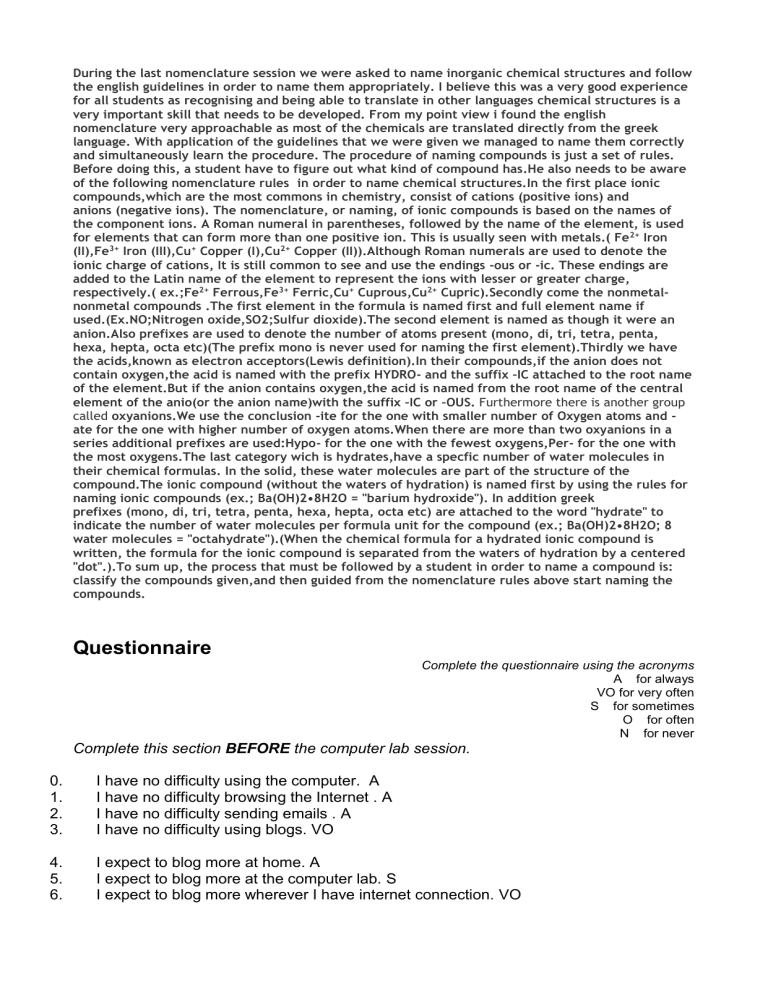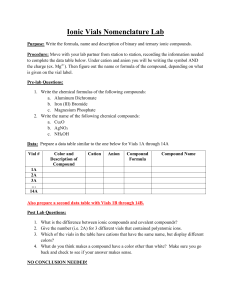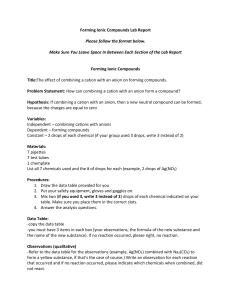assignment1

During the last nomenclature session we were asked to name inorganic chemical structures and follow the english guidelines in order to name them appropriately. I believe this was a very good experience for all students as recognising and being able to translate in other languages chemical structures is a very important skill that needs to be developed. From my point view i found the english nomenclature very approachable as most of the chemicals are translated directly from the greek language. With application of the guidelines that we were given we managed to name them correctly and simultaneously learn the procedure. The procedure of naming compounds is just a set of rules.
Βefore doing this, a student have to figure out what kind of compound has.He also needs to be aware of the following nomenclature rules in order to name chemical structures.In the first place ionic compounds,which are the most commons in chemistry, consist of cations (positive ions) and anions (negative ions). The nomenclature, or naming, of ionic compounds is based on the names of the component ions. A Roman numeral in parentheses, followed by the name of the element, is used for elements that can form more than one positive ion. This is usually seen with metals.( Fe 2+ Iron
(II),Fe 3+ Iron (III),Cu + Copper (I),Cu 2+ Copper (II)).Although Roman numerals are used to denote the ionic charge of cations, It is still common to see and use the endings -ous or -ic. These endings are added to the Latin name of the element to represent the ions with lesser or greater charge, respectively.( ex.;Fe 2+ Ferrous,Fe 3+ Ferric,Cu + Cuprous,Cu 2+ Cupric).Secondly come the nonmetalnonmetal compounds .The first element in the formula is named first and full element name if used.(Ex.NO;Nitrogen oxide,SO2;Sulfur dioxide).The second element is named as though it were an anion.Also prefixes are used to denote the number of atoms present (mono, di, tri, tetra, penta, hexa, hepta, octa etc)(The prefix mono is never used for naming the first element).Thirdly we have the acids,known as electron acceptors(Lewis definition).In their compounds,if the anion does not contain oxygen,the acid is named with the prefix HYDRO- and the suffix –IC attached to the root name of the element.But if the anion contains oxygen,the acid is named from the root name of the central
element of the anio(or the anion name)with the suffix –IC or –OUS. Furthermore there is another group called oxyanions.We use the conclusion -ite for the one with smaller number of Oxygen atoms and - ate for the one with higher number of oxygen atoms.When there are more than two oxyanions in a series additional prefixes are used:Hypo- for the one with the fewest oxygens,Per- for the one with the most oxygens.The last category wich is hydrates,have a specfic number of water molecules in their chemical formulas. In the solid, these water molecules are part of the structure of the compound.The ionic compound (without the waters of hydration) is named first by using the rules for naming ionic compounds (ex.; Ba(OH)2•8H2O = "barium hydroxide"). In addition greek prefixes (mono, di, tri, tetra, penta, hexa, hepta, octa etc) are attached to the word "hydrate" to indicate the number of water molecules per formula unit for the compound (ex.; Ba(OH)2•8H2O; 8 water molecules = "octahydrate").(When the chemical formula for a hydrated ionic compound is written, the formula for the ionic compound is separated from the waters of hydration by a centered
"dot".).To sum up, the process that must be followed by a student in order to name a compound is: classify the compounds given,and then guided from the nomenclature rules above start naming the compounds.
Questionnaire
Complete the questionnaire using the acronyms
A for always
VO for very often
S for sometimes
O for often
N for never
Complete this section BEFORE the computer lab session.
0.
I have no difficulty using the computer. A
1.
I have no difficulty browsing the Internet . A
2.
I have no difficulty sending emails . A
3.
I have no difficulty using blogs. VO
4.
I expect to blog more at home. A
5.
I expect to blog more at the computer lab. S
6.
I expect to blog more wherever I have internet connection. VO
7.
I have no difficulty understanding written English. VO
8.
I have no difficulty understanding written English for Chemistry. A
9.
I have no difficulty writing English. A
10.
I have no difficulty writing English for Chemistry. VO
11.
I expect to learn something in this class. A
12.
I expect to get positive feedback from my classmates. VO
13.
I expect to get positive feedback from my teacher. VO
14.
I expect to write for an audience with shared interests. VO
15.
I expect to improve my writing in this class. A
16.
I expect to improve my mark. A
Complete this section AFTER the computer lab session.
17.
I enjoyed blogging in this class. A
18.
I enjoyed reading the posts of my classmates and giving feedback. A
19.
I enjoyed learning from the posts or comments of my classmates. A
20.
I enjoyed receiving comments on my posts by my classmates. A
21.
I enjoyed receiving comments on my posts by my teacher. A
22.
I find blogging interactive . A
23.
I found blogging user-friendly. A
24.
I found the teacher’s instruction on “how to blog” helpful and easy to follow. A
25.
I learned something through blogging A
26.
I learnt easier with blogging than with in-class exercises. VO
27.
I had more time to think and reflect with blogging. A
28.
I improved my writing with blogging. A
29.
I preferred giving positive feedback. VO
30.
I read all the helpful links on the side before I started writing. A
31.
I checked the rubrics guidelines before I gave feedback. A
32.
I enjoyed taking part in the process of voting for the best Final Version. A
33.
I blogged mostly when at home. A
34.
I blogged mostly when at the University computer lab. O




